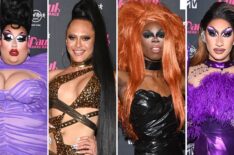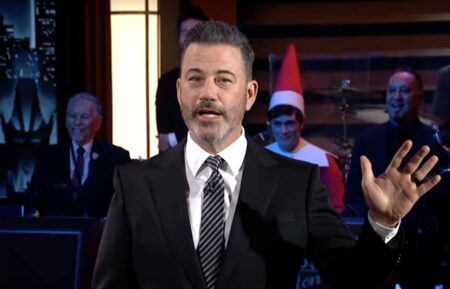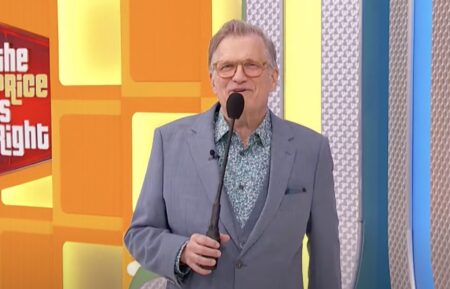How ‘RuPaul’s Drag Race’ Grew From Niche Classic to Emmy-Winning Hit

Emmys
“The first thing Ru said was, ‘I’ll do anything but a competition elimination show.'” So says Emmy-winning executive producer Tom Campbell, who was in the room where it happened when the idea for RuPaul’s Drag Race first came to be nearly two decades ago. In an exclusive interview with TV Insider during the 2022-23 Emmys voting period, Campbell took us through Drag Race‘s fabulous history, from the first meeting where its format and most of its iconic catchphrases were born through its multi-network rise to being one of television’s most successful reality competition series.
With his 12 total trophies and seven consecutive wins for Outstanding Host for a Reality or Competition Program, RuPaul has won the most Emmys of any Black artist in history (he’s nominated again this year). Campbell, who works for World of Wonder (the production company behind the Drag Race and Million Dollar Listing franchises and more) says the show’s success was unexpected because of the different world in which it got started.
Drag Race‘s on-air history is a visual representation of America’s incremental acceptance of the LGBTQIA+ community. “We taped our first season many years ago. The Bush administration was still [in office] in 2008. We knew it was coming out in [February 2009]. We were like, ‘I wonder if it will be President Obama or President Sarah Palin’s Running Mate?'” he jokes.
“We weren’t thinking Emmys” when creating the show in 2008, Campbell says. But he notes there was “something fortuitous about the fact that, as the world opened up, Drag Race got roots in the ground.” Still, the growth didn’t come easy. RuPaul — a fixture of pop culture for decades as the world’s most recognizable drag queen — and his team shopped their idea around to friends at networks like Bravo and E! before landing at Logo, the show’s first of three networks. The responses were shocking.
“When we pitched the show in 2008, World of Wonder had shows on E! and Bravo. We went to our friends and we thought, ‘Oh my god, we have this great idea. RuPaul’s going to do this thing. It’s going to parody reality [TV], but it’s also going to be a real show to celebrate the art of drag,'” Campbell recalls. “And our friends would listen to the pitch with Ru. They’d laugh, ‘We love you, we love you!’ And they would lean in and say, ‘But we’re not gonna be able to get this past our sales guys. You know that, right?'”
Queer Eye for the Straight Guy had ended its four-season run in October 2007. The original Queer as Folk had ended in August 2005. The L Word would be on-air for one more year, its March 2009 series finale airing just one month after Drag Race‘s debut. These were the few shows queer people had back in the early aughts, but even RuPaul’s global fame wasn’t enough to convince mainstream networks that another show made for queer people, by queer people, was worthy of a green light.
Logo was the only network to give Drag Race a shot, “which at the time didn’t seem like the best place to be,” says Campbell. “It ended up being the most supportive place for the show to grow and for us to be left alone and to make something fabulous by receiving support of the network. And so we weren’t thinking Emmys. We just wanted to be on the next year. There was every reason that they could pull the plug. For the first many years, it was like, will we even be back next year? And we were, and we were. And we loved what we did.”

©Logo / Courtesy: Everett Collection
As the years went on, the show became more of a niche classic, its fanbase primarily consisting of queer people. And for a long time, Drag Race was the only show on TV made exclusively and deliberately for that community. Campbell remembers being “the biggest show on the smallest network” back on Logo. Despite the “teeny tiny” viewing numbers, he says there was a feeling that “everybody knows about this show,” proving to him that its audience wasn’t just gay men. “Taste influencers,” he says, were often bringing it up, so something good was clearly happening.
Drag Race and Logo’s symbiotic rise hit its inflection point in 2015. The first DragCon (Comic-Con for drag, the first of its kind) kicked off on May 16. “We just were like, ‘We know there’s a lot of people who watch the show, and we want to see them in person,'” Campbell shares. The convention was “this amazing moment where parents, kids, goth people, drag queens” came together for a joyful display of “full-on expression.” The joy continued when Drag Race got its first Emmy nomination on July 16. Same-sex marriage was legalized in the United States 10 days later on July 26. Ru won Outstanding Host for the first time the following year, marking Drag Race‘s first Emmy win. He hasn’t lost since. Now, Drag Race has 26 Emmys under its bedazzled belt, four being the top honor of Outstanding Competition Program (2018, 2019, 2020, and 2021).
Drag Race has succeeded against all odds, but primarily because it’s simply good TV. The spark of creation hit the team like a wrecking ball in that first meeting all those years ago. As Campbell says, “a good idea takes birth very quickly.” “In 2008 when we were talking, [reality competition shows] were kind of mean,” Campbell says of Ru’s initial refusal to do an elimination series. “There were the Simon Cowells and there were the Joe Millionaires.”
The original idea for the show was more similar to Strangers with Candy, the campy, irreverent comedy poking fun at sitcoms starring a young Amy Sedaris and Stephen Colbert. Like Strangers With Candy, their show would make fun of TV with the added bonus of celebrating an underrepresented community. Considering World of Wonder’s difficulty to sell the series due to discriminatory gatekeeping in Hollywood, that format ended up being an unintentionally radical notion.
“We presented it to [Drag Race producers Randy Barbato and Fenton Bailey], and we laughed and laughed,” Campbell reminisces. “Somehow in all of this, Ru said, ‘You know what we need to do? We need to do a competition elimination show that celebrates the art of drag.’ And so in that room, most of the beats that exist in the show today — the Lip-Sync for Your Life, the challenges, even the title RuPaul’s Drag Race — came alive around that table.”
Ideas came out like word vomit, most of them not needing any tweaks. “The time has come for you to lip-sync for your LIFE!” and other “format beats that everyone knows” were products of that first meeting. It wasn’t long before they realized they needed criteria. “I said, ‘It should spell boobs or something,'” he recalls. “And they came back to me with charisma, uniqueness, nerve, and talent. I’m like, sold. Sold! Perfect.” “Good luck, and don’t f**k it up” was drummed up later in the development process. Campbell was convinced Logo would reject that part of the first script, which was overdue to the network.
“I was like, ‘Ugh, I can’t believe you put f**k in the script. We’re never gonna get this cleared. Send it!'” he says. “We sent it, they’re like, ‘Fine, we’ll just bleep it out.’ And then, ‘don’t f**k it up’ was born. So, you know, it was all meant to be.”
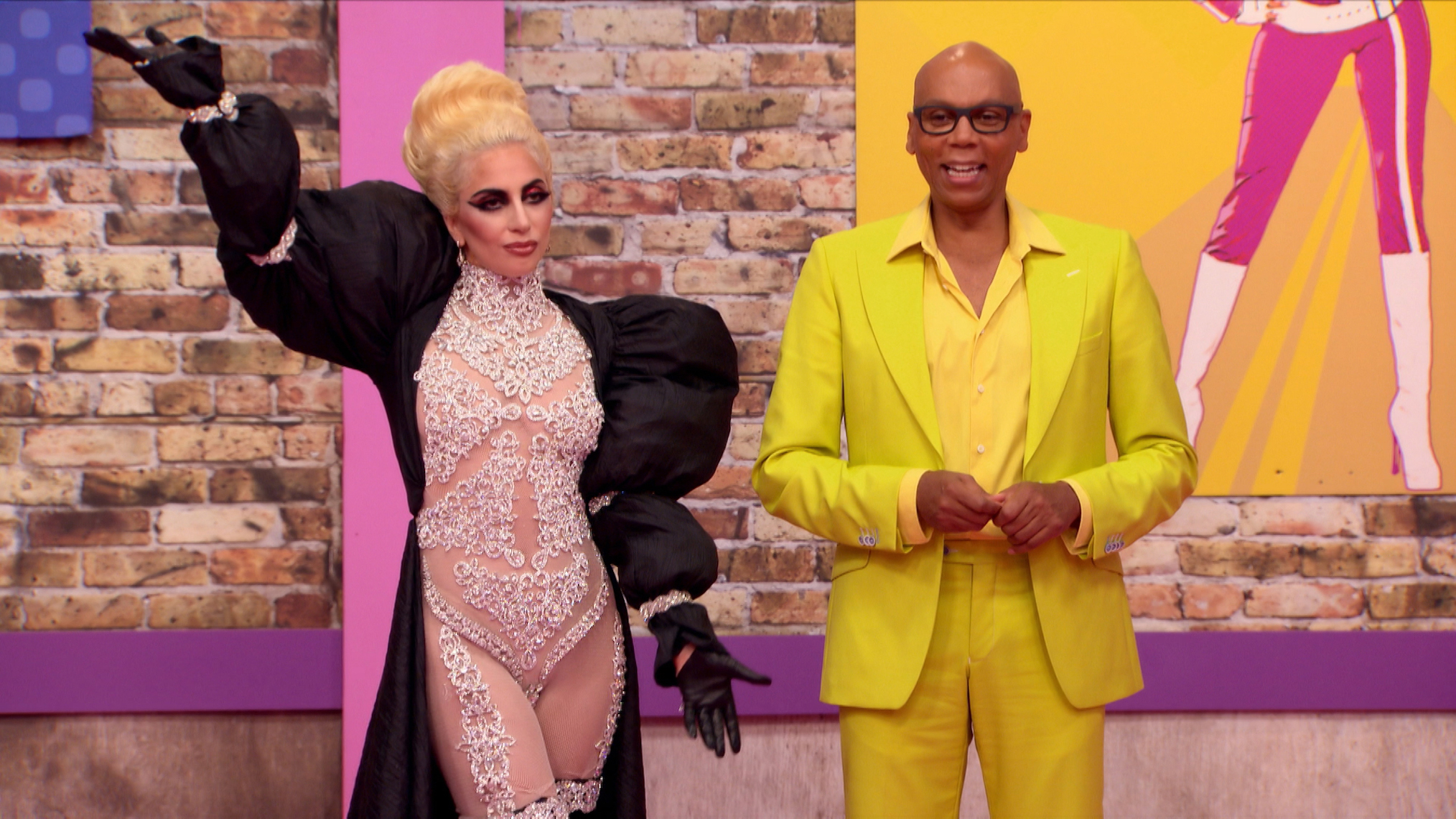
Lady Gaga and RuPaul in ‘RuPaul’s Drag Race’ Season 9 (Credit: Everett Collection)
Fifteen seasons and three networks in, Campbell doesn’t take “any day, any show, any episode, any season” for granted. “I think of Drag Race as a healthy tree that somehow grew out of a crack in the sidewalk,” he says. “We were given this little opportunity on Logo. I’m so grateful that they gave it to us. And from VH1 to MTV to Paramount+ and the Paramount family supporting us, it’s been an incredible journey.”
Shows being saved by networks and streamers is a rare phenomenon these days, but a show being bumped up to increasingly popular networks is practically unheard of. After eight years on Logo, Drag Race first aired on VH1 in 2017, then it debuted on MTV in 2023. RuPaul’s Drag Race Untucked follows the mainstay show wherever it goes, and RuPaul’s Drag Race All Stars airs exclusively on Paramount+. (Logo, VH1, MTV, and Paramount+ are all under the Viacom umbrella.) Campbell says the show’s moves up the Viacom chain have been entirely network decisions, seemingly based on how well the show has performed year after year. Campbell credits this rise to the multi-generational team that makes Drag Race run.
“RuPaul is the perfect person” to lead this charge, says Campbell. “This is all inspired by him. It is all his brainchild. It is his sense of humor and sensibility that infuses everything we do. So on one end, you have the producers and RuPaul who are one generation. We have different people sort of in the middle generation who work on the show. And then we have the queens who often are this brand new generation. There’s this incredible back and forth of learning.”
Success has never been guaranteed. “Queer show or not queer show,” Campbell says, “it’s hard to get people to watch. But there’s something about Drag Race that goes way beyond being a queer show, even though it is 100 percent made by queer people, starring queer people.” Because of its cast of queens from “different socioeconomic backgrounds and different ways to identify,” Campbell believes the series is “constantly learning and growing and attracting people who have love in their hearts.”
Any queen who has competed on the series will tell you that getting cast on Drag Race is enough to launch a full-time drag career. All Stars Season 8 runner-up Kandy Muse told TV Insider that RuPaul is “the person who has created an income for drag queens” through his career and the competition series. Most competition programs serve as launch pads for a career in the public eye: American Idol gave us Kelly Clarkson; Dancing With the Stars put ballroom dance on the map and is the best dance gig in the business; The Bachelor franchise stars become influencers; and Jury Duty‘s unwitting star Ronald Gladden will always be famous. But the Drag Race platform is unparalleled.
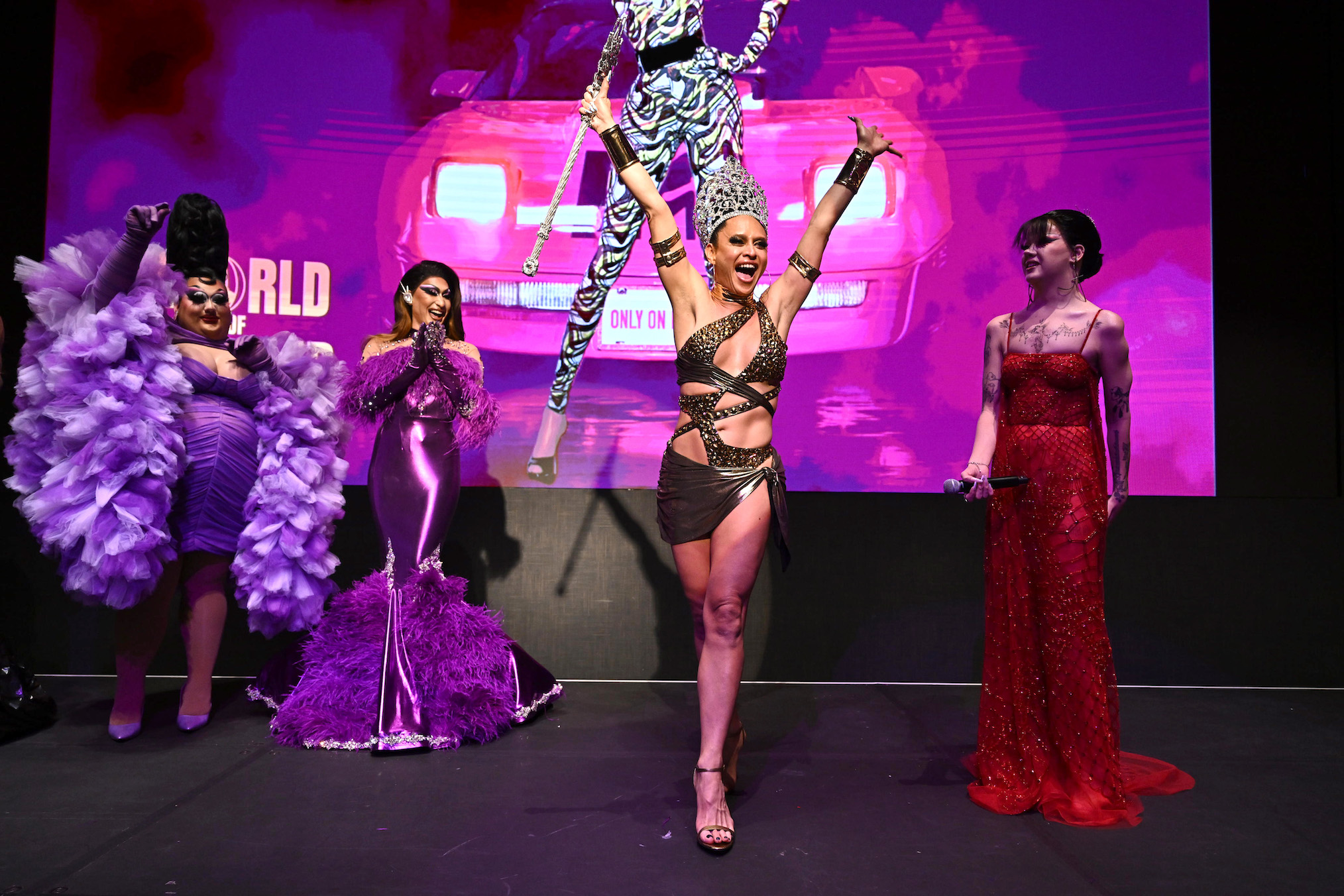
‘RuPaul’s Drag Race’ Season 15 winner Sasha Colby celebrates her win at NYC’s Hard Rock Hotel (Credit: Dave Kotinsky/Getty Images for MTV)
Following her Season 15 win, drag icon Sasha Colby told TV Insider that being the franchise’s reigning queen “means that I can be of better service” to the trans community. With this exposure, she can normalize “what it means to be a happy trans person” in a time when trans rights are under attack in the U.S. The show has become increasingly inclusive to trans artists over the years, a change fans have celebrated.
Drag Race constantly changes its rules each season, often to the shock of contestants and viewers alike. It’s part of how the show continues its original intent to poke fun at reality competition programs at large. No seasons are exactly alike as a result. One shocking change, however, came in Season 14, when Maddy Morphosis was the first cisgender straight man to compete. Some fans noted it was alarming to see a straight man cast before a drag king. Campbell doesn’t rule out the possibility of drag kings being able to compete in future seasons.
“I never say no to anything,” he says. “It’s a little bit of apples and oranges in terms of a competition, but it’s not outside of the [realm of] possibility, no. It could always happen.”
Another surprising change was in Season 15, when the episodes were shortened from 90 minutes to one hour. No matter the network, Drag Race has always clocked in at 90 minutes. The episodes returned to that original form halfway through Season 15. Campbell confirms that the change was, in fact, due to fan outcry over episode length. “Fans wanted it, and everyone responded, so that’s wonderful,” he says, adding, “I think everybody wanted it” to return to its longer runtime.
How does one sum up the appeal of Drag Race? “It’s the transformation, it’s the makeup, it’s the subculture, it’s the language,” Campbell argues. “It’s the love, which sounds so corny, but, you know, RuPaul’s brand has been about love. ‘Everybody say love!’ Ru will say the show goes to everyone because it’s about the tenacity of the human spirit, which sounds very lofty, but it’s kind of true.”
“This particular group of people is underrepresented, under-appreciated. Even when we started Drag Race, I don’t think people understood drag. A lot of people didn’t understand drag, even the queer community, as an art form, which it is,” he continues. “But the most important thing we do is we provide this platform for people to be vulnerable, to tell their stories, and to feel safe to tell their stories. I think it’s really hard to turn away from that. You don’t have to be a drag queen or queer to have felt like an outsider, to feel like you have something to express, that you want to use all the colors in the crayon box, that you want to sing and dance and express yourself.”
Being the one queer show to survive the test of time puts added responsibility on the show’s proverbial shoulders, but it’s a task the team is always willing to take on. “Drag queens have always been on the frontline of social change when it comes to our community. And it’s no different now, even though we’re this quote unquote hit show. We still have to represent the community and not buy into the theater.”
“My favorite expression is, ‘We’re all born naked and the rest is drag,'” Campbell says of RuPaul’s beloved end-of-episode catchphrase, “which is the smartest, most efficient number of words to say, ‘Well, what are drag queens? What do they do? Are they men? Are they women?’ We’re all born naked and the rest is drag. It’s like, thank you, RuPaul.”
RuPaul’s Drag Race, Streaming Now, Paramount+



